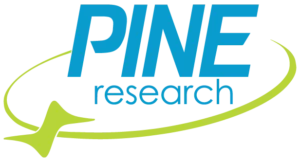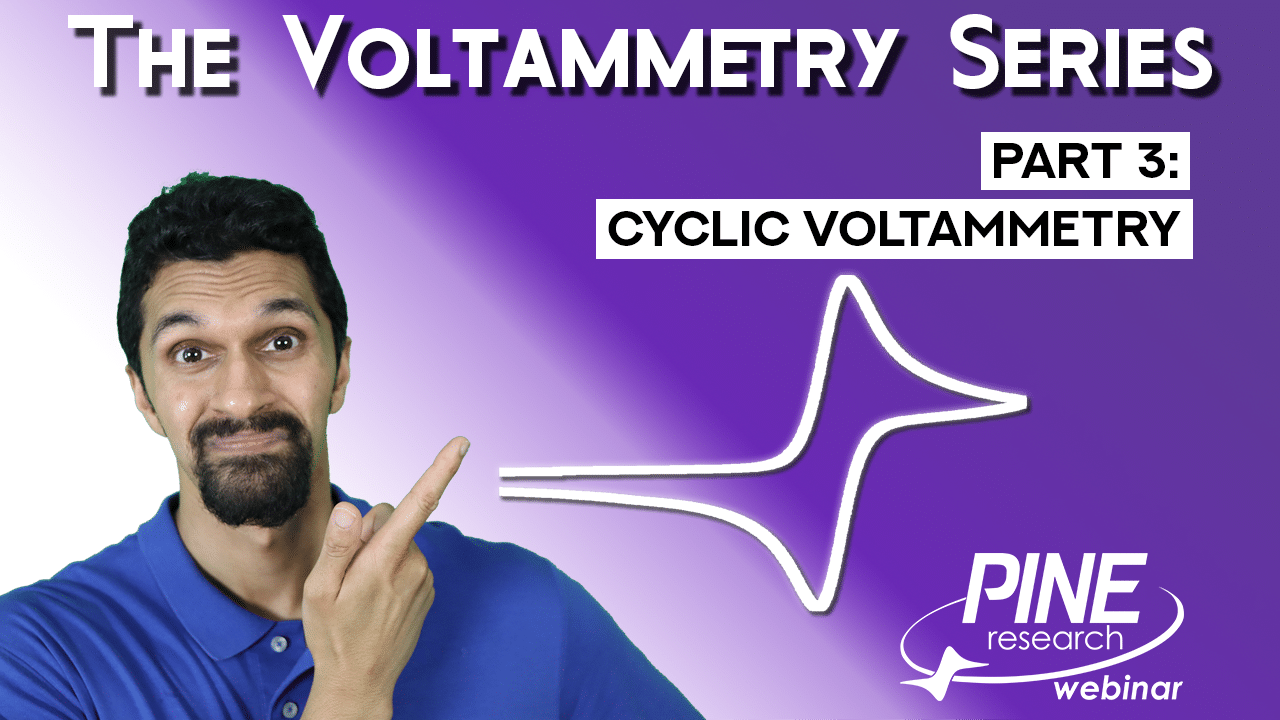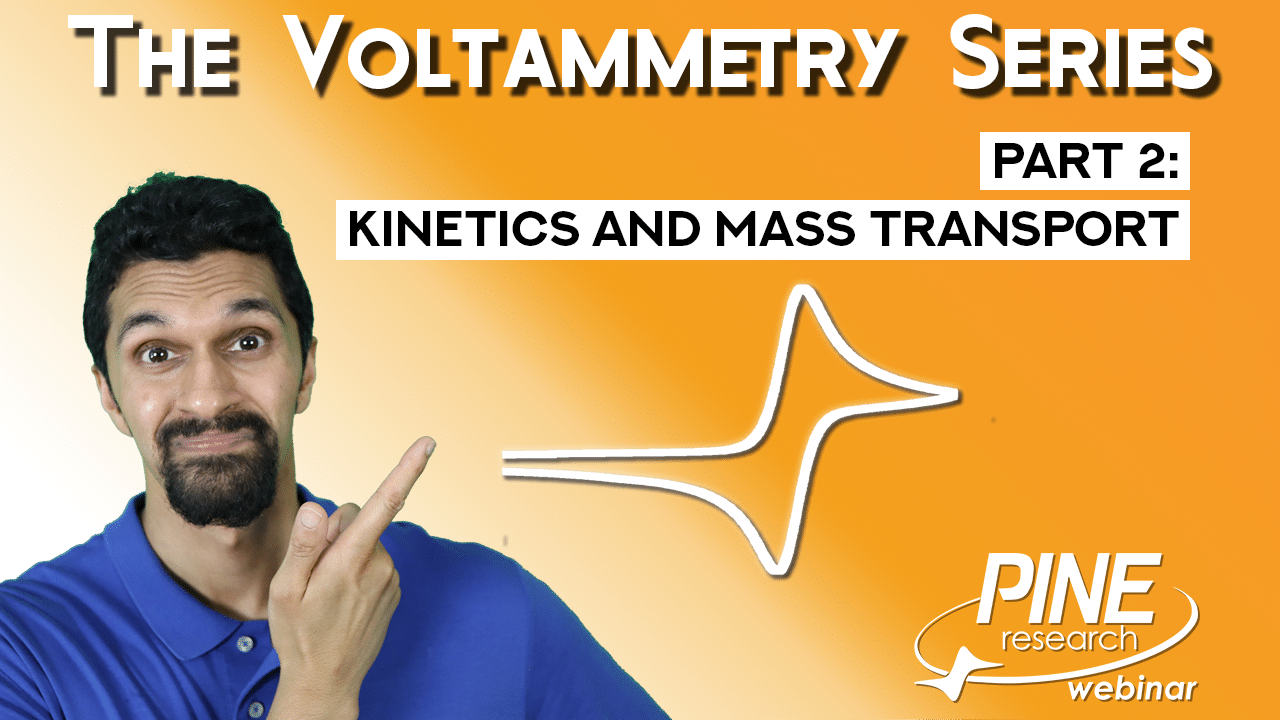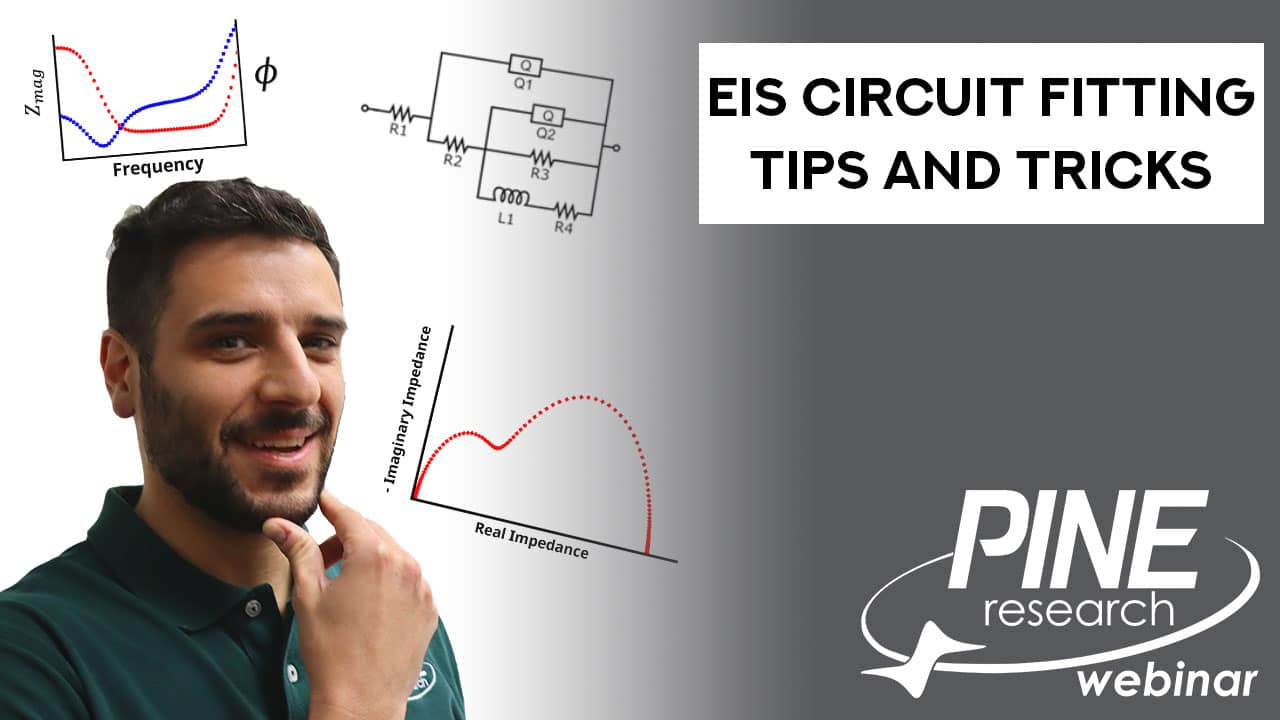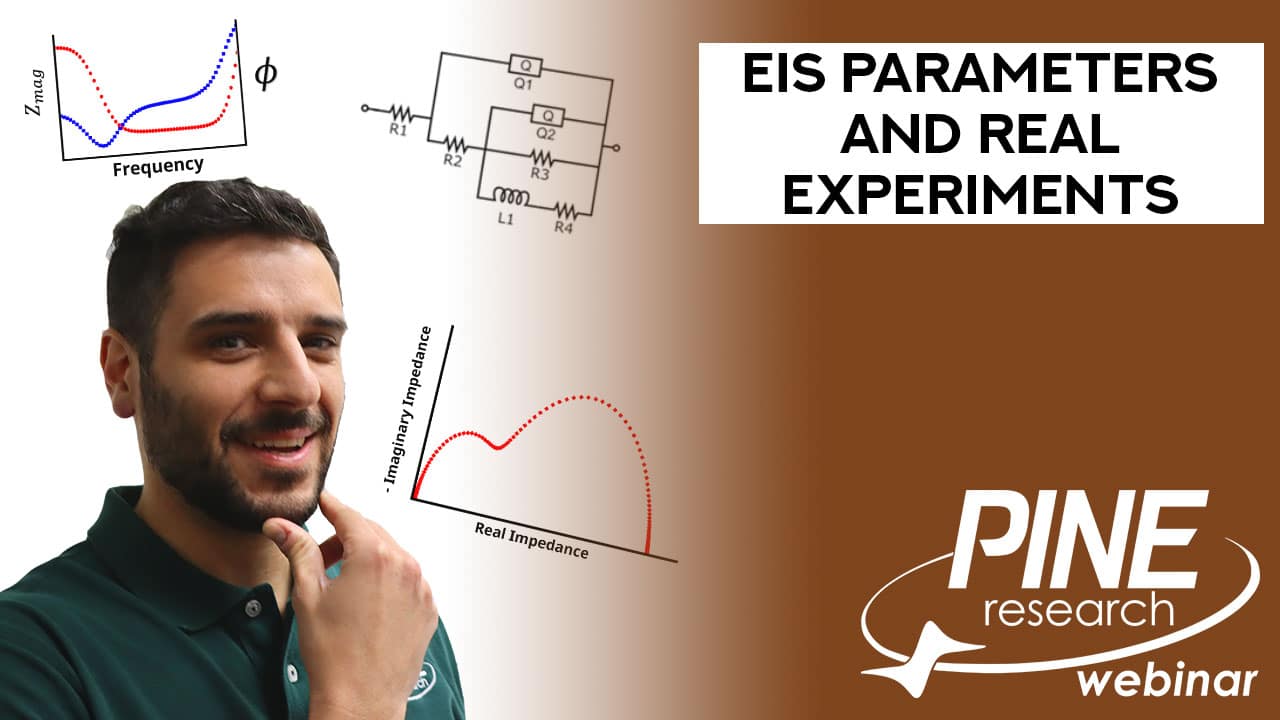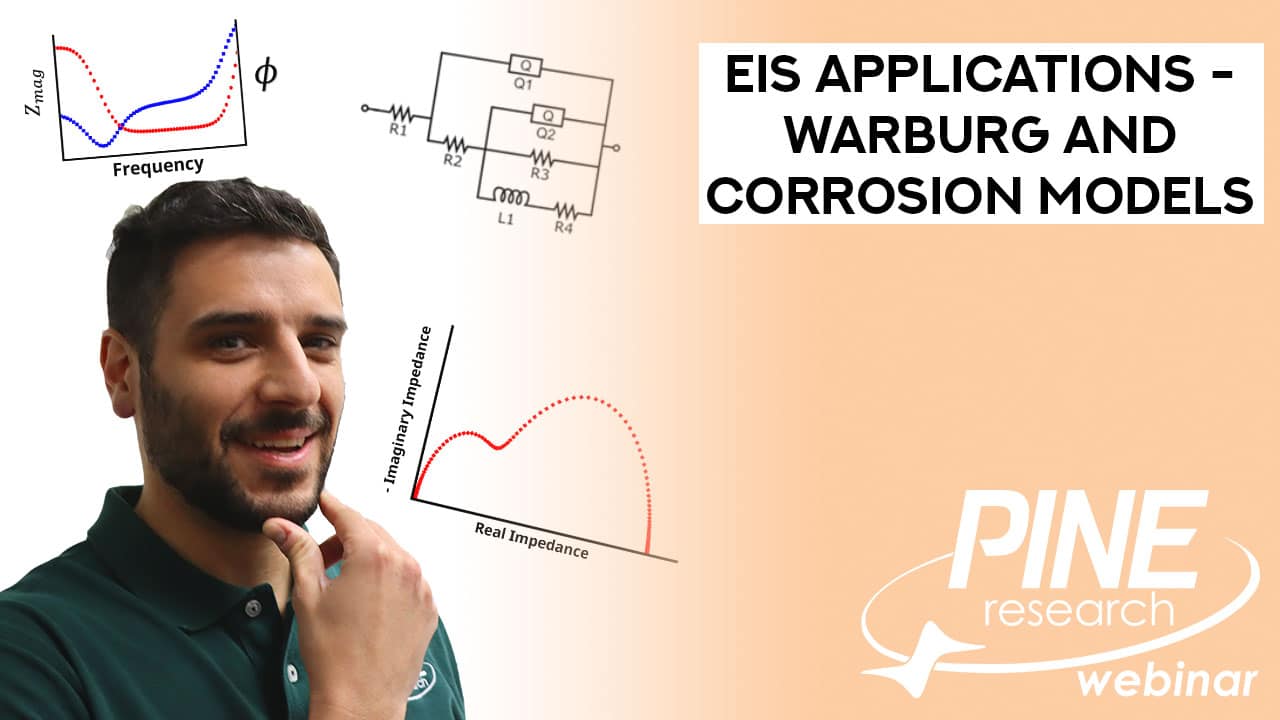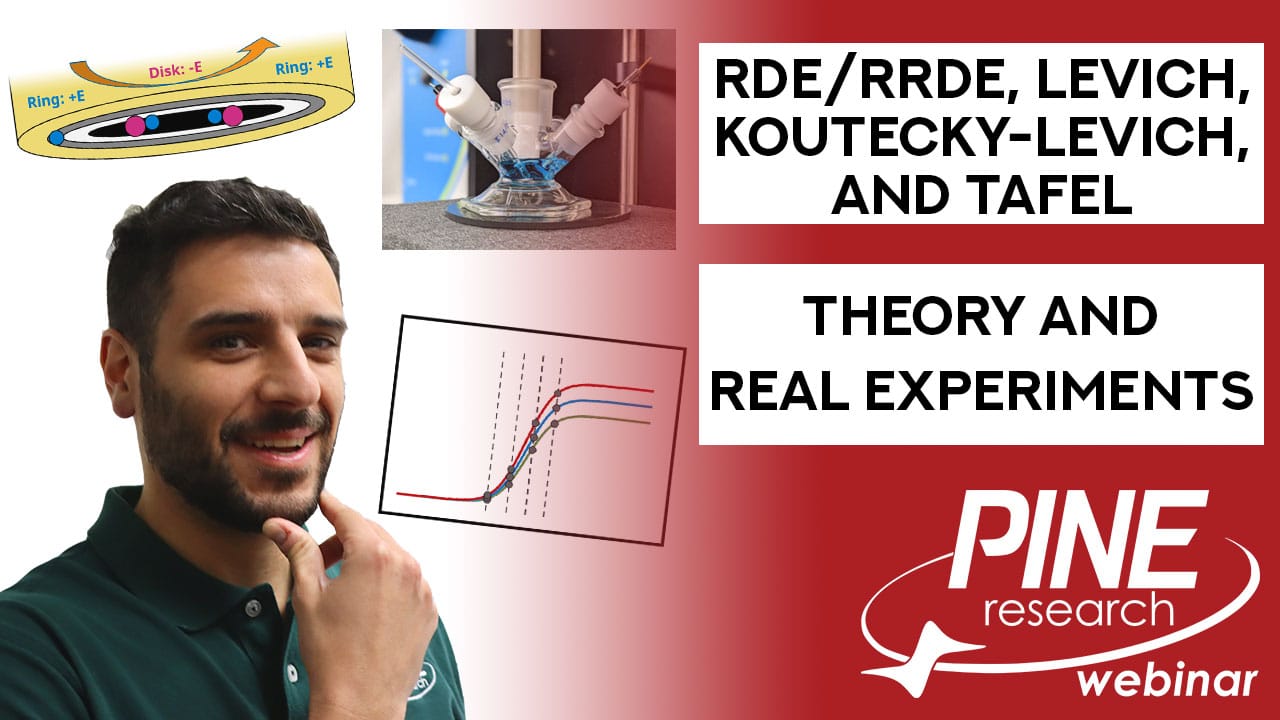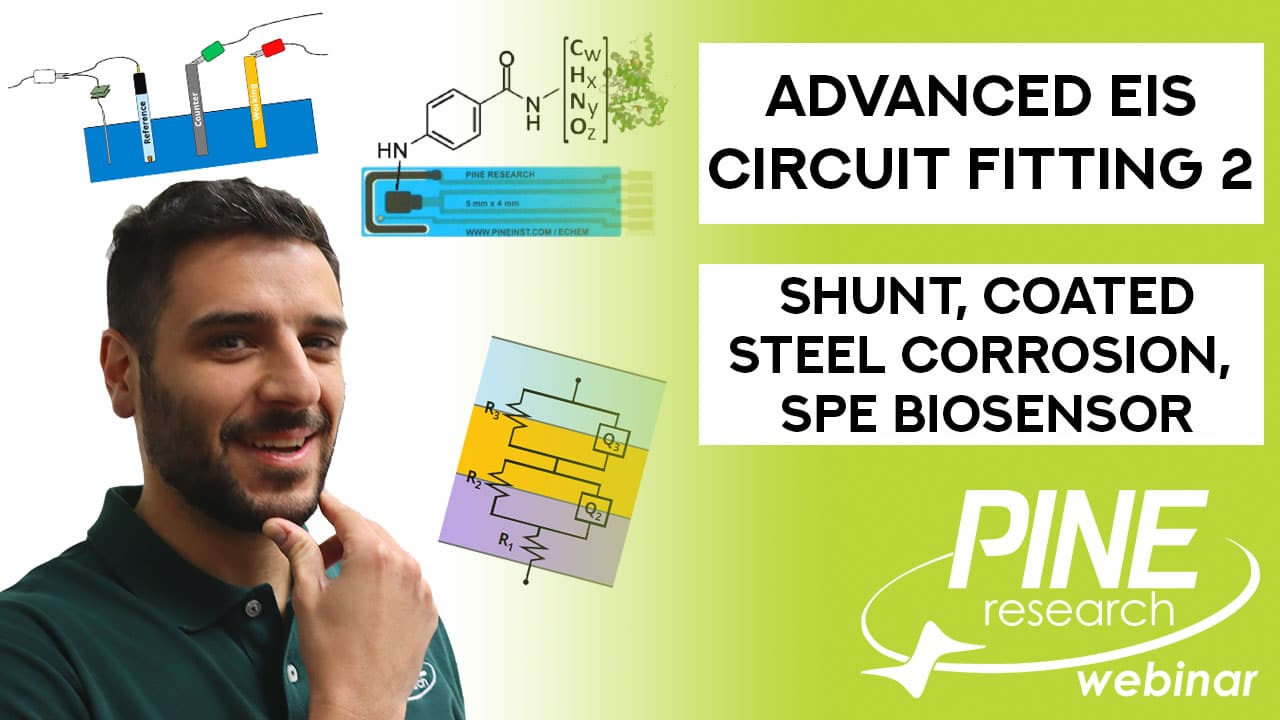Webinars
Pine Research started offering webinars in 2020, mostly as a response to the COVID-19 pandemic; however, given the attendance, there still exists a significant demand for webinars. The cornerstone webinar series is based on Electrochemical Impedance Spectroscopy (EIS). Pine Research plans to host webinars in a wide variety of electrochemical topics. This page will provide you with a list of upcoming and past webinars, with registration information when available.
Upcoming Webinars
We do not currently have any webinars scheduled. Please visit this page often and follow us on X and LinkedIn to know when webinars get scheduled. If you are looking to watch a webinar on a specific topic of significant interest, let us know and we can add it to our list.
Past Webinars
21:00 GMT
Mott-Schottky is an electrochemical impedance spectroscopy (EIS) technique used to study semiconductor properties. This webinar starts with basics of molecular orbitals, atomic structure, and band theory, followed by principles of semiconductors (band gap, intrinsic vs. extrinsic, n-type and p-type, Fermi level, band bending, and space charge capacitance). Finally, Mott-Schottky analysis and mathematics are explained.
13:00 GMT
Mott-Schottky is an electrochemical impedance spectroscopy (EIS) technique used to study semiconductor properties. This webinar starts with basics of molecular orbitals, atomic structure, and band theory, followed by principles of semiconductors (band gap, intrinsic vs. extrinsic, n-type and p-type, Fermi level, band bending, and space charge capacitance). Finally, Mott-Schottky analysis and mathematics are explained.
20:00 GMT
In Part 4 we will continue talking about cyclic voltammetry and discuss a few more details regarding interpretation of voltammograms and coupled chemical reactions. The last topic will be on advanced voltammetry techniques such as pulse techniques like differential pulse voltammetry
12:00 GMT
In Part 4 we will continue talking about cyclic voltammetry and discuss a few more details regarding interpretation of voltammograms and coupled chemical reactions. The last topic will be on advanced voltammetry techniques such as pulse techniques like differential pulse voltammetry
20:00 GMT
In Part 3 we take all the concepts of potential, electrode kinetics, and mass transport and we use them to understand cyclic voltammetry. Topics include chronoamperometry, cyclic voltammetry, understanding voltametric response, and practical aspects of performing voltammetry.
12:00 GMT
In Part 3 we take all the concepts of potential, electrode kinetics, and mass transport and we use them to understand cyclic voltammetry. Topics include chronoamperometry, cyclic voltammetry, understanding voltametric response, and practical aspects of performing voltammetry.
20:00 GMT
Part 2 covers the concept of electrode kinetics, Butler-Volmer vs Marcus theory, mass transport and diffusion.
12:00 GMT
Part 2 covers the concept of electrode kinetics, Butler-Volmer vs Marcus theory, mass transport and diffusion.
20:00 GMT
Part 1 covers what is voltammetry, electrochemical potential, Nernst equation, electrical double layer, working electrodes, and reference electrodes.
12:00 GMT
Part 1 covers what is voltammetry, electrochemical potential, Nernst equation, electrical double layer, working electrodes, and reference electrodes.
21:00 GMT
This webinar covers electrochemical impedance spectroscopy (EIS) circuit fitting, tips and tricks in AfterMath Blue software, special features, and general strategies.
13:00 GMT
This webinar covers electrochemical impedance spectroscopy (EIS) circuit fitting, tips and tricks in AfterMath Blue software, special features, and general strategies.
21:00 GMT
This webinar covers electrochemical impedance spectroscopy (EIS) parameters, potentiostatic vs. galvanostatic EIS, how to choose experimental parameters, software control, experimental flow, and real EIS experiments live.
13:00 GMT
This webinar covers electrochemical impedance spectroscopy (EIS) parameters, potentiostatic vs. galvanostatic EIS, how to choose experimental parameters, software control, experimental flow, and real EIS experiments live.
20:00 GMT
This webinar covers applications of electrochemical impedance spectroscopy (EIS), specifically electrochemical interfaces, circuit elements, Warburg models, both infinite and finite, and corrosion models.
12:00 GMT
This webinar covers applications of electrochemical impedance spectroscopy (EIS), specifically electrochemical interfaces, circuit elements, Warburg models, both infinite and finite, and corrosion models.
20:00 GMT
This webinar covers applications of electrochemical impedance spectroscopy (EIS), specifically electrochemical interfaces, circuit elements, RC/RQ circuits, capacitors vs. constant phase elements (CPEs), and series vs. embedded models.
12:00 GMT
This webinar covers applications of electrochemical impedance spectroscopy (EIS), specifically electrochemical interfaces, circuit elements, RC/RQ circuits, capacitors vs. constant phase elements (CPEs), and series vs. embedded models.
20:00 GMT
This webinar covers the basics of electrochemical impedance spectroscopy (EIS), including theory behind the technique, data processing, Bode/Nyquist plots, data accuracy and validity, and use of the Kramers-Kronig transforms.
12:00 GMT
This webinar covers the basics of electrochemical impedance spectroscopy (EIS), including theory behind the technique, data processing, Bode/Nyquist plots, data accuracy and validity, and use of the Kramers-Kronig transforms.
21:00 GMT
This webinar covers basics of how a potentiostat works, including feedback loops and operational amplifiers, as well as uncompensated resistance, where it comes from and how to correct for it.
13:00 GMT
This webinar covers basics of how a potentiostat works, including feedback loops and operational amplifiers, as well as uncompensated resistance, where it comes from and how to correct for it.
21:00 GMT
This webinar covers rotating disk electrode (RDE) and rotating ring-disk electrode (RRDE) electrochemistry, specifically the data analysis of methods such as Levich, Koutecky-Levich, Tafel, and collection efficiency.
13:00 GMT
This webinar covers rotating disk electrode (RDE) and rotating ring-disk electrode (RRDE) electrochemistry, specifically the data analysis of methods such as Levich, Koutecky-Levich, Tafel, and collection efficiency.
21:00 GMT
This webinar covers rotating disk electrode (RDE) and rotating ring-disk electrode (RRDE) electrochemistry, including the theory of kinetics and diffusion as well as methods such as Levich, Koutecky-Levich, Tafel, and collection efficiency determination. Live RRDE experiments are also shown to collect real data to be analyzed in a separate webinar.
13:00 GMT
This webinar covers rotating disk electrode (RDE) and rotating ring-disk electrode (RRDE) electrochemistry, including the theory of kinetics and diffusion as well as methods such as Levich, Koutecky-Levich, Tafel, and collection efficiency determination. Live RRDE experiments are also shown to collect real data to be analyzed in a separate webinar.
21:00 GMT
This webinar covers electrochemical impedance spectroscopy (EIS) circuit fitting, tips and tricks in AfterMath Blue software, special features, and general strategies.
13:00 GMT
This webinar covers electrochemical impedance spectroscopy (EIS) circuit fitting, tips and tricks in AfterMath Blue software, special features, and general strategies.
21:00 GMT
This webinar covers electrochemical impedance spectroscopy (EIS) parameters, potentiostatic vs. galvanostatic EIS, how to choose experimental parameters, software control, experimental flow, and real EIS experiments live.
13:00 GMT
This webinar covers electrochemical impedance spectroscopy (EIS) parameters, potentiostatic vs. galvanostatic EIS, how to choose experimental parameters, software control, experimental flow, and real EIS experiments live.
21:00 GMT
This webinar covers applications of electrochemical impedance spectroscopy (EIS), specifically electrochemical interfaces, circuit elements, Warburg models, both infinite and finite, and corrosion models.
13:00 GMT
This webinar covers applications of electrochemical impedance spectroscopy (EIS), specifically electrochemical interfaces, circuit elements, Warburg models, both infinite and finite, and corrosion models.
21:00 GMT
This webinar covers applications of electrochemical impedance spectroscopy (EIS), specifically electrochemical interfaces, circuit elements, RC/RQ circuits, capacitors vs. constant phase elements (CPEs), and series vs. embedded models.
13:00 GMT
This webinar covers applications of electrochemical impedance spectroscopy (EIS), specifically electrochemical interfaces, circuit elements, RC/RQ circuits, capacitors vs. constant phase elements (CPEs), and series vs. embedded models.
21:00 GMT
This webinar covers the basics of electrochemical impedance spectroscopy (EIS), including theory behind the technique, data processing, Bode/Nyquist plots, data accuracy and validity, and use of the Kramers-Kronig transforms.
13:00 GMT
This webinar covers the basics of electrochemical impedance spectroscopy (EIS), including theory behind the technique, data processing, Bode/Nyquist plots, data accuracy and validity, and use of the Kramers-Kronig transforms.
21:00 GMT
This webinar covers rotating disk electrode (RDE) and rotating ring-disk electrode (RRDE) electrochemistry, specifically the data analysis of methods such as Levich, Koutecky-Levich, Tafel, and collection efficiency.
13:00 GMT
This webinar covers rotating disk electrode (RDE) and rotating ring-disk electrode (RRDE) electrochemistry, specifically the data analysis of methods such as Levich, Koutecky-Levich, Tafel, and collection efficiency.
21:00 GMT
This webinar covers rotating disk electrode (RDE) and rotating ring-disk electrode (RRDE) electrochemistry, including the theory of kinetics and diffusion as well as methods such as Levich, Koutecky-Levich, Tafel, and collection efficiency determination. Live RRDE experiments are also shown to collect real data to be analyzed in a separate webinar.
13:00 GMT
This webinar covers rotating disk electrode (RDE) and rotating ring-disk electrode (RRDE) electrochemistry, including the theory of kinetics and diffusion as well as methods such as Levich, Koutecky-Levich, Tafel, and collection efficiency determination. Live RRDE experiments are also shown to collect real data to be analyzed in a separate webinar.
20:00 GMT
This webinar covers advanced circuit fitting of electrochemical impedance spectroscopy (EIS) data submitted by researchers to Pine Research. Two cases are analyzed: a nickel hydroxide electrode used for glucose oxidation, and a coin cell battery with blocking conditions used to determine tortuosity via transmission line circuit models.
12:00 GMT
This webinar covers advanced circuit fitting of electrochemical impedance spectroscopy (EIS) data submitted by researchers to Pine Research. Two cases are analyzed: a nickel hydroxide electrode used for glucose oxidation, and a coin cell battery with blocking conditions used to determine tortuosity via transmission line circuit models.
19:30 GMT
This webinar covers electrochemical impedance spectroscopy (EIS) circuit fitting, tips and tricks in AfterMath Blue software, special features, and general strategies.
14:00 GMT
This webinar covers electrochemical impedance spectroscopy (EIS) circuit fitting, tips and tricks in AfterMath Blue software, special features, and general strategies.
05:00 GMT
This webinar covers electrochemical impedance spectroscopy (EIS) circuit fitting, tips and tricks in AfterMath Blue software, special features, and general strategies.
19:30 GMT
This webinar covers electrochemical impedance spectroscopy (EIS) parameters, potentiostatic vs. galvanostatic EIS, how to choose experimental parameters, software control, experimental flow, and real EIS experiments live.
14:00 GMT
This webinar covers electrochemical impedance spectroscopy (EIS) parameters, potentiostatic vs. galvanostatic EIS, how to choose experimental parameters, software control, experimental flow, and real EIS experiments live.
05:00 GMT
This webinar covers electrochemical impedance spectroscopy (EIS) parameters, potentiostatic vs. galvanostatic EIS, how to choose experimental parameters, software control, experimental flow, and real EIS experiments live.
19:30 GMT
This webinar covers applications of electrochemical impedance spectroscopy (EIS), specifically electrochemical interfaces, circuit elements, Warburg models, both infinite and finite, and corrosion models.
14:00 GMT
This webinar covers applications of electrochemical impedance spectroscopy (EIS), specifically electrochemical interfaces, circuit elements, Warburg models, both infinite and finite, and corrosion models.
05:00 GMT
This webinar covers applications of electrochemical impedance spectroscopy (EIS), specifically electrochemical interfaces, circuit elements, Warburg models, both infinite and finite, and corrosion models.
19:30 GMT
This webinar covers applications of electrochemical impedance spectroscopy (EIS), specifically electrochemical interfaces, circuit elements, RC/RQ circuits, capacitors vs. constant phase elements (CPEs), and series vs. embedded models.
14:00 GMT
This webinar covers applications of electrochemical impedance spectroscopy (EIS), specifically electrochemical interfaces, circuit elements, RC/RQ circuits, capacitors vs. constant phase elements (CPEs), and series vs. embedded models.
05:00 GMT
This webinar covers applications of electrochemical impedance spectroscopy (EIS), specifically electrochemical interfaces, circuit elements, RC/RQ circuits, capacitors vs. constant phase elements (CPEs), and series vs. embedded models.
19:30 GMT
This webinar covers the basics of electrochemical impedance spectroscopy (EIS), including theory behind the technique, data processing, Bode/Nyquist plots, data accuracy and validity, and use of the Kramers-Kronig transforms.
14:00 GMT
This webinar covers the basics of electrochemical impedance spectroscopy (EIS), including theory behind the technique, data processing, Bode/Nyquist plots, data accuracy and validity, and use of the Kramers-Kronig transforms.
05:00 GMT
This webinar covers the basics of electrochemical impedance spectroscopy (EIS), including theory behind the technique, data processing, Bode/Nyquist plots, data accuracy and validity, and use of the Kramers-Kronig transforms.
20:00 GMT
This webinar covers advanced circuit fitting of electrochemical impedance spectroscopy (EIS) data submitted by researchers to Pine Research. Two cases are analyzed: a coated steel corrosion and use of a shunt, and a modified screen-printed electrode (SPE) biosensor.
14:00 GMT
This webinar covers advanced circuit fitting of electrochemical impedance spectroscopy (EIS) data submitted by researchers to Pine Research. Two cases are analyzed: a coated steel corrosion and use of a shunt, and a modified screen-printed electrode (SPE) biosensor.
05:00 GMT
This webinar covers advanced circuit fitting of electrochemical impedance spectroscopy (EIS) data submitted by researchers to Pine Research. Two cases are analyzed: a coated steel corrosion and use of a shunt, and a modified screen-printed electrode (SPE) biosensor.
20:00 GMT
This webinar covers advanced circuit fitting of electrochemical impedance spectroscopy (EIS) data submitted by researchers to Pine Research. Two cases are analyzed: a proton-exchange membrane (PEM) fuel cell and a perovskite film.
12:00 GMT
This webinar covers advanced circuit fitting of electrochemical impedance spectroscopy (EIS) data submitted by researchers to Pine Research. Two cases are analyzed: a proton-exchange membrane (PEM) fuel cell and a perovskite film.
20:00 GMT
This webinar covers electrochemical impedance spectroscopy (EIS) circuit fitting, tips and tricks in AfterMath Blue software, special features, and general strategies.
12:00 GMT
This webinar covers electrochemical impedance spectroscopy (EIS) circuit fitting, tips and tricks in AfterMath Blue software, special features, and general strategies.
21:00 GMT
This webinar covers electrochemical impedance spectroscopy (EIS) parameters, potentiostatic vs. galvanostatic EIS, how to choose experimental parameters, software control, experimental flow, and real EIS experiments live.
13:00 GMT
This webinar covers electrochemical impedance spectroscopy (EIS) parameters, potentiostatic vs. galvanostatic EIS, how to choose experimental parameters, software control, experimental flow, and real EIS experiments live.
21:00 GMT
This webinar covers applications of electrochemical impedance spectroscopy (EIS), specifically electrochemical interfaces, circuit elements, Warburg models, both infinite and finite, and corrosion models.
13:00 GMT
This webinar covers applications of electrochemical impedance spectroscopy (EIS), specifically electrochemical interfaces, circuit elements, Warburg models, both infinite and finite, and corrosion models.
21:00 GMT
This webinar covers applications of electrochemical impedance spectroscopy (EIS), specifically electrochemical interfaces, circuit elements, RC/RQ circuits, capacitors vs. constant phase elements (CPEs), and series vs. embedded models.
13:00 GMT
This webinar covers applications of electrochemical impedance spectroscopy (EIS), specifically electrochemical interfaces, circuit elements, RC/RQ circuits, capacitors vs. constant phase elements (CPEs), and series vs. embedded models.
21:00 GMT
This webinar covers the basics of electrochemical impedance spectroscopy (EIS), including theory behind the technique, data processing, Bode/Nyquist plots, data accuracy and validity, and use of the Kramers-Kronig transforms.
13:00 GMT
This webinar covers the basics of electrochemical impedance spectroscopy (EIS), including theory behind the technique, data processing, Bode/Nyquist plots, data accuracy and validity, and use of the Kramers-Kronig transforms.
